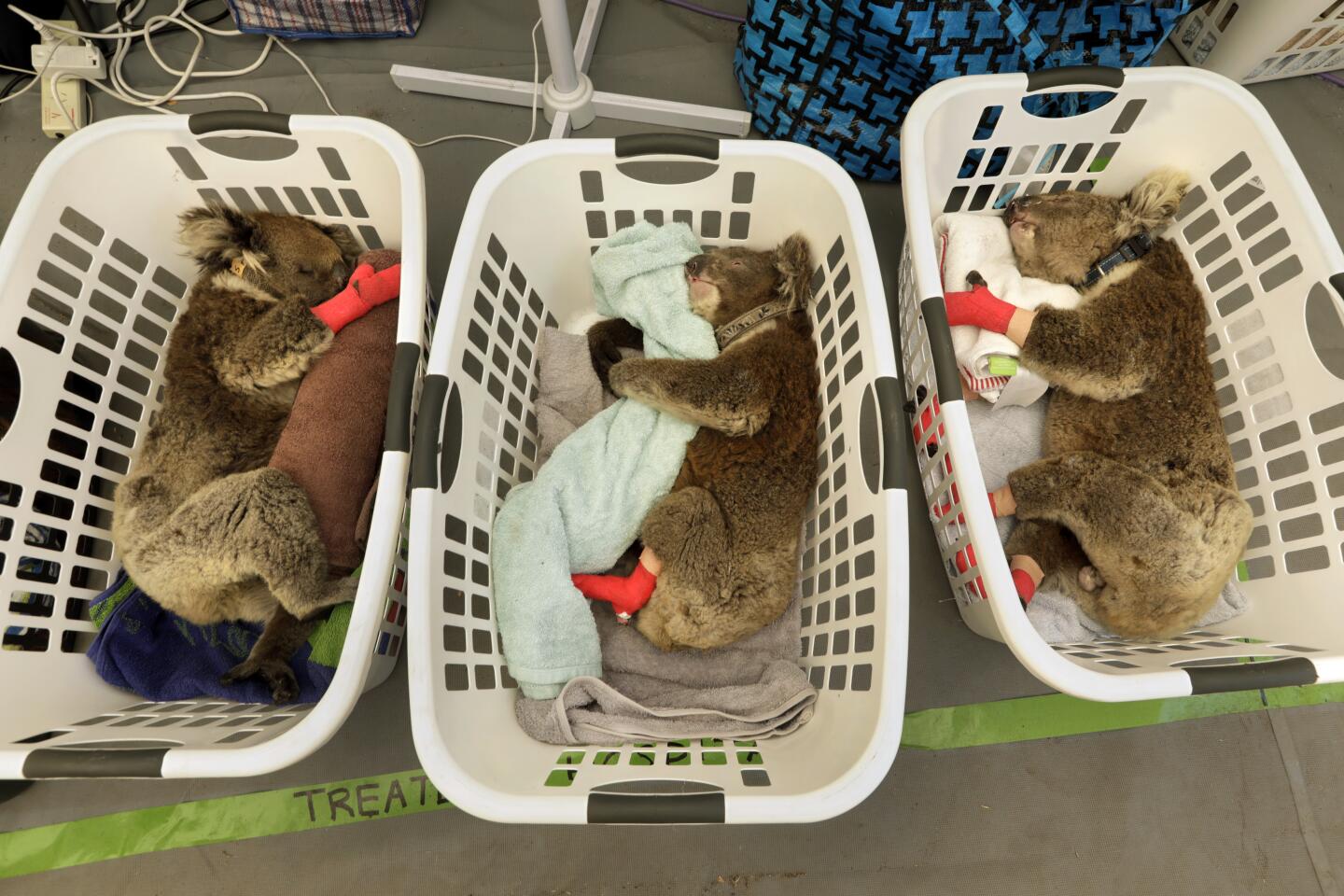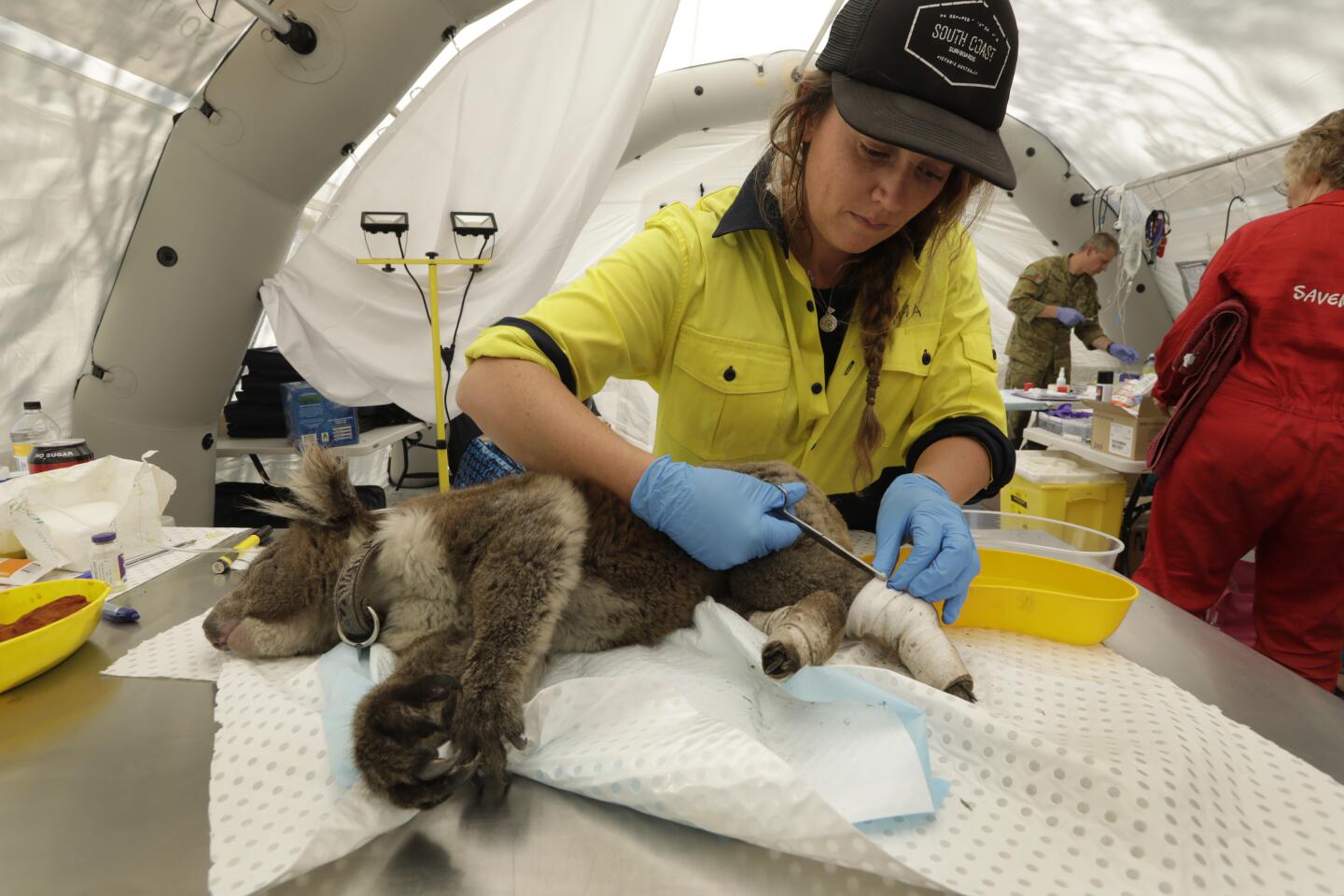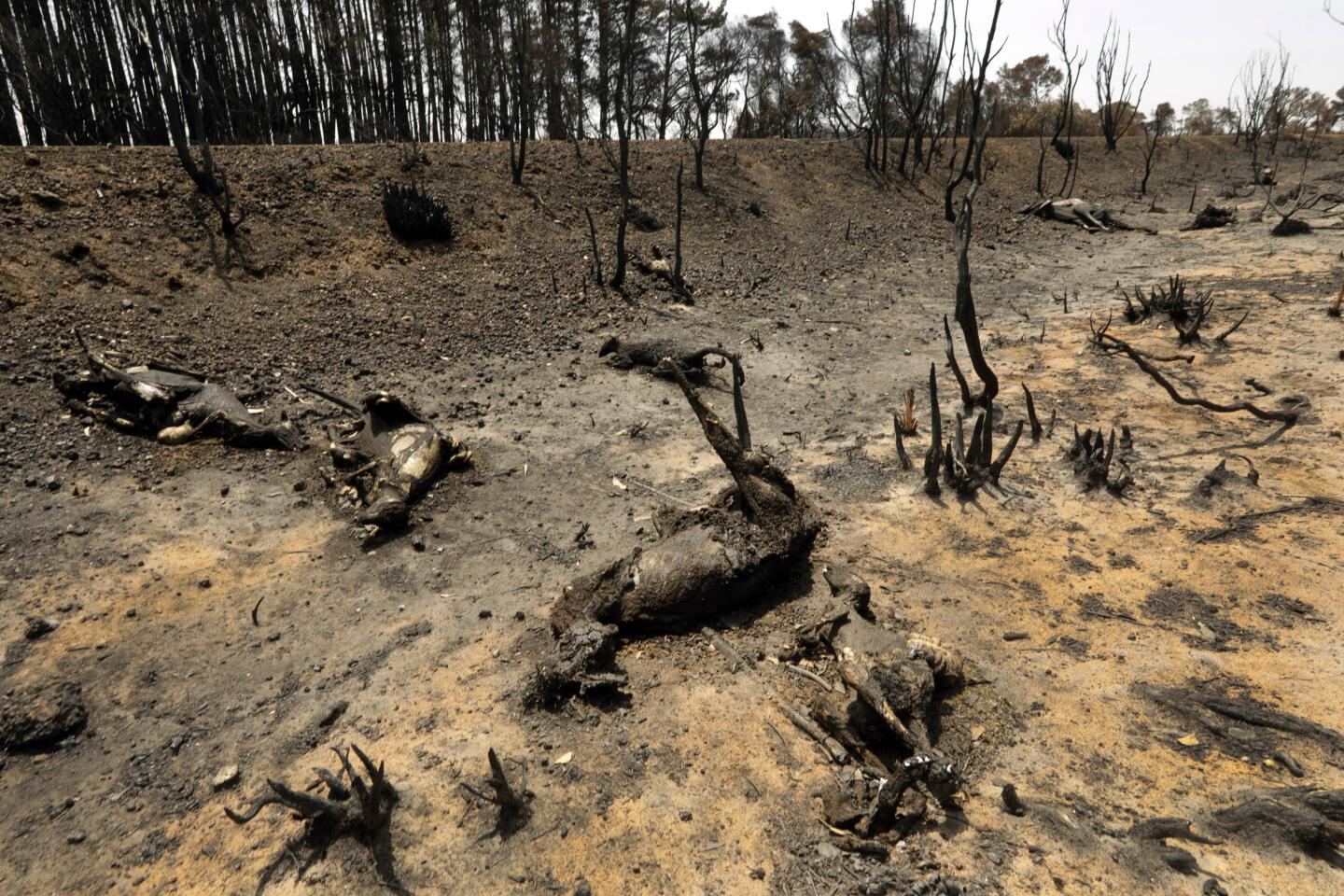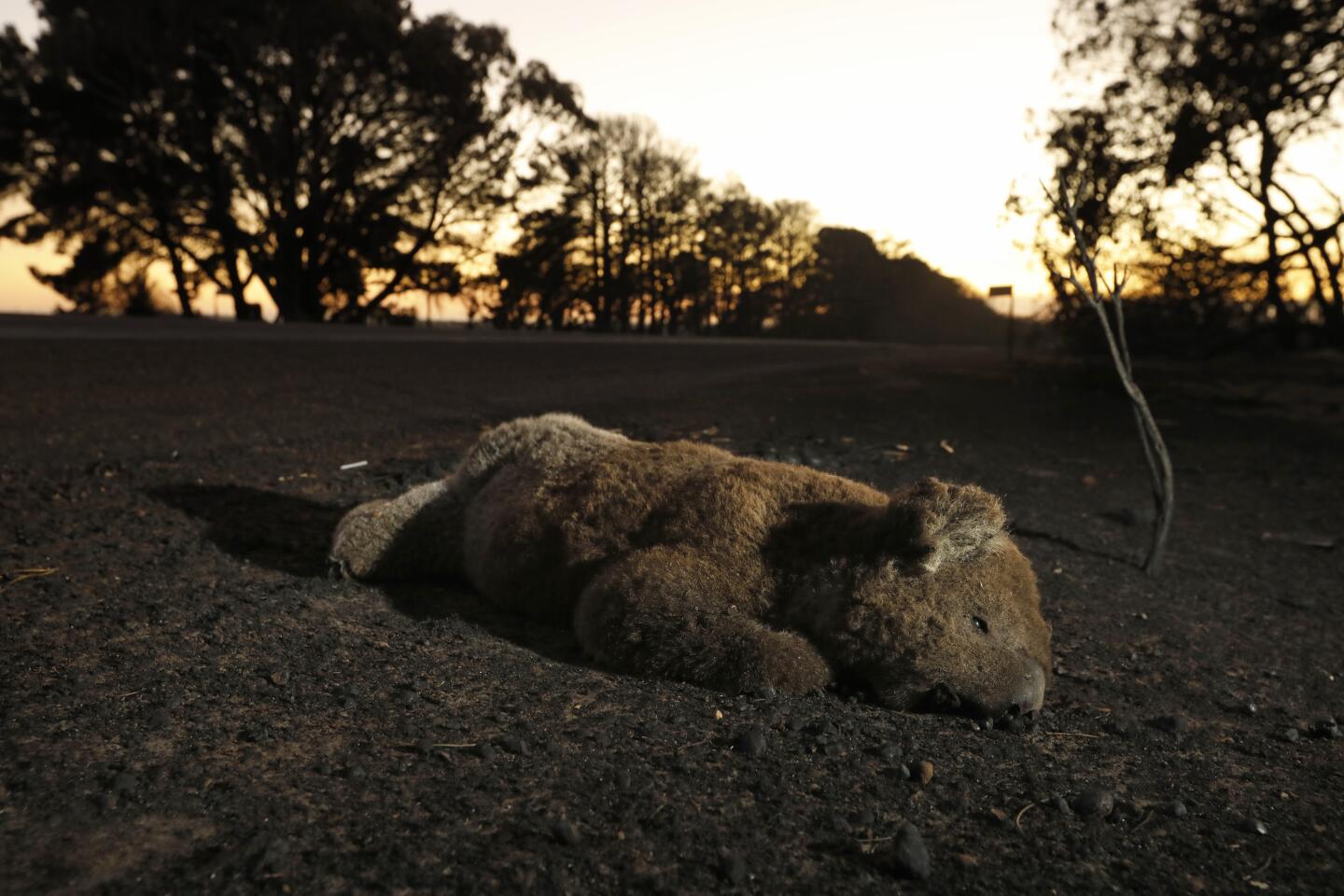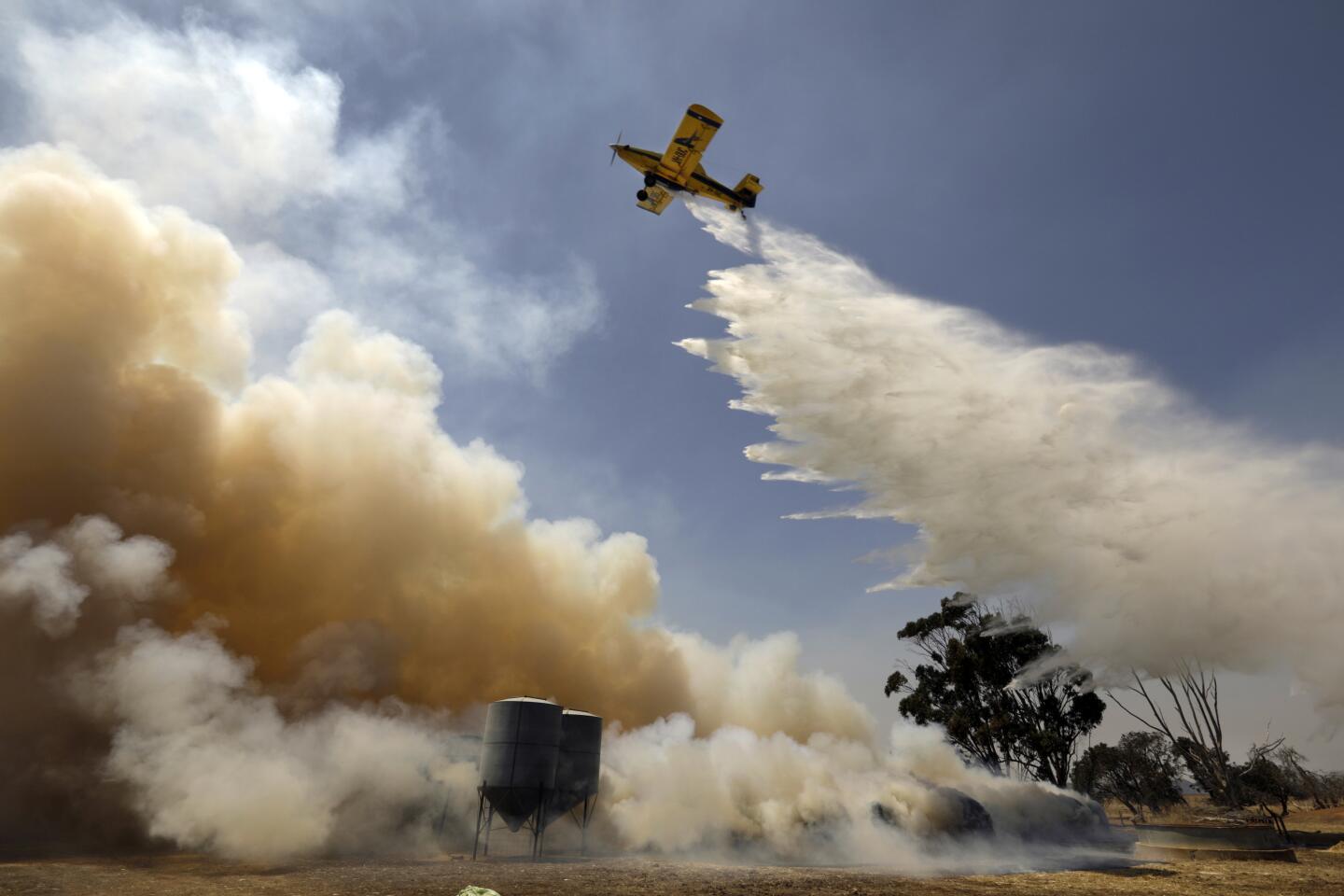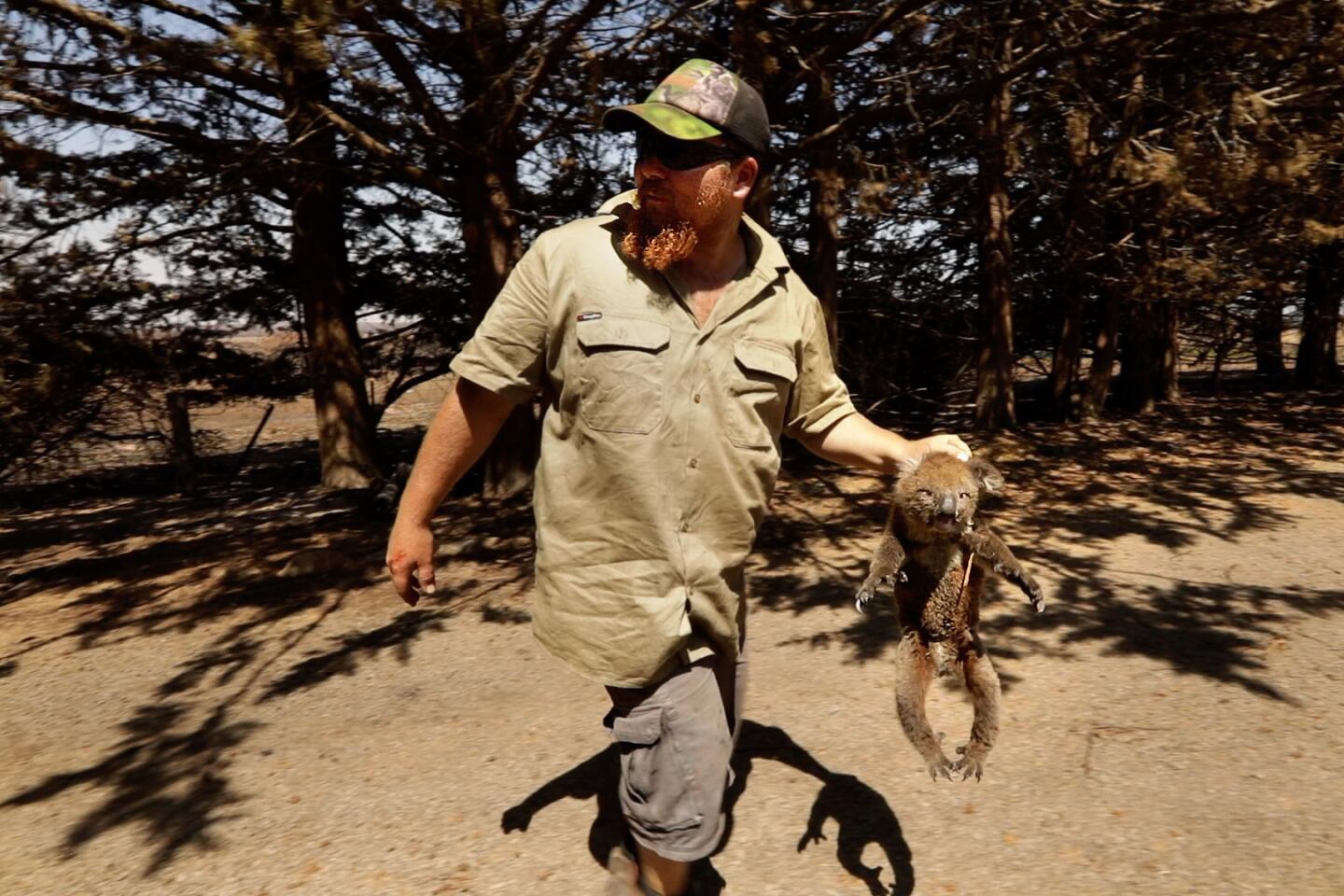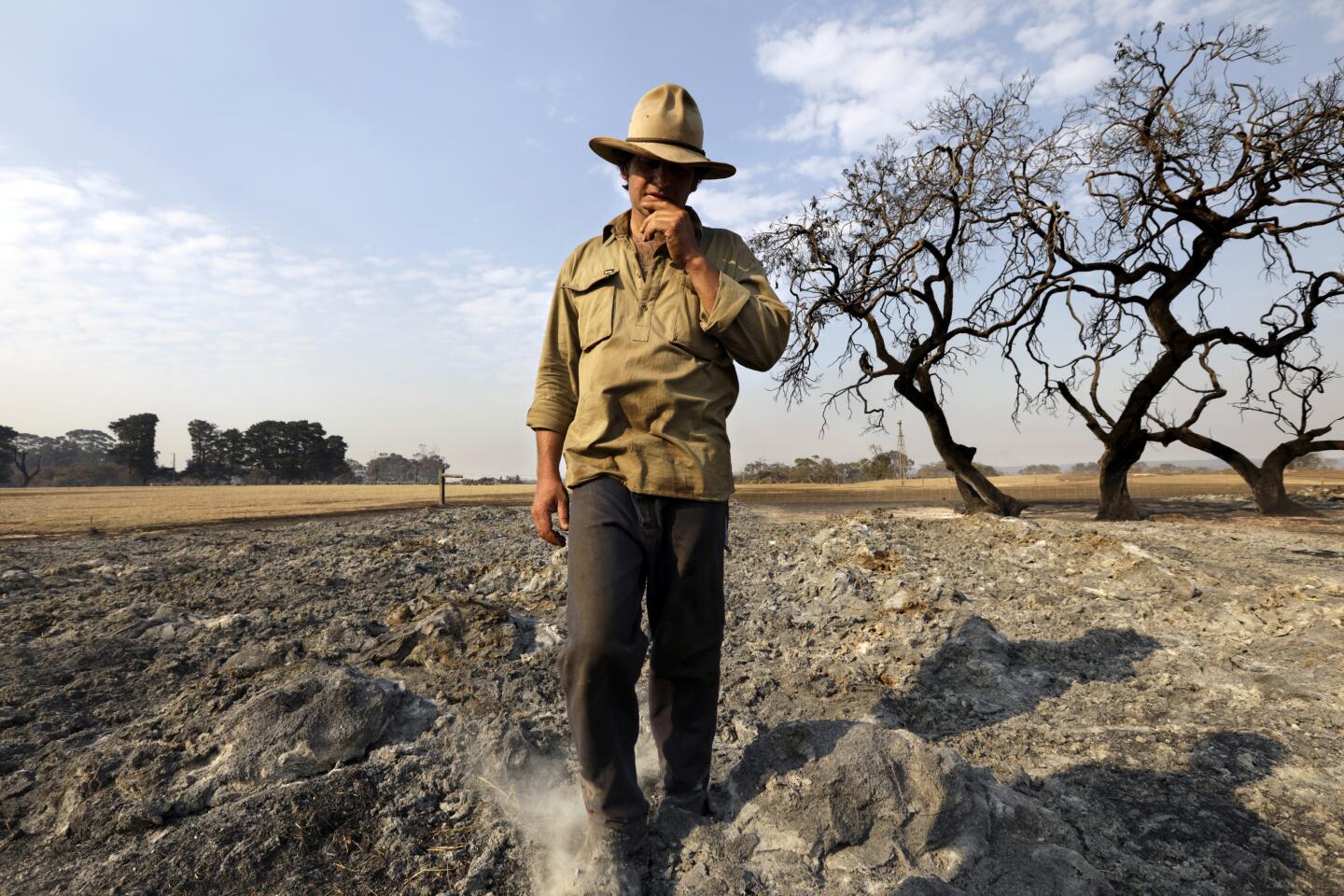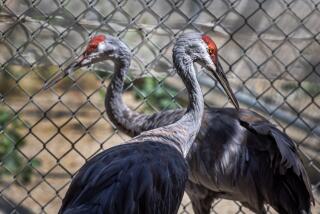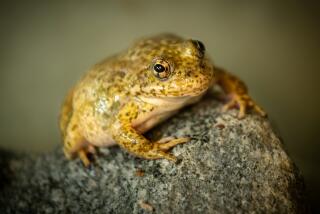
KANGAROO ISLAND, Australia — Sam Mitchell balanced himself on a eucalyptus branch 30 feet above the ground as his meaty left fist clutched a koala, which wailed like a pig with breathing problems. The dark gray marsupial batted its 3-inch black claws in the air helplessly, and minutes later Mitchell crawled down. He and the animal were safely on the ground.
Across much of Australia, volunteers and professionals are fighting to contain widespread blazes, with many also taking risks to save wildlife being killed by the millions. Kangaroo Island, a popular tourist destination and wildlife park off Australia’s southeast coast, has seen some of the worst damage to the nation’s biodiversity. Fires have overrun nearly half of the 1,700-square-mile island, and rescuers have been going tree to tree, trying to save what they can.
“There’s not much that isn’t threatening koalas at the moment,” said Mitchell, who has owned and run the Kangaroo Island Wildlife Park with his wife, Dana, the last seven years. The couple started a GoFundMe campaign so people can help with the rescues. Without quick intervention, koalas that survived the fires “are going to die of starvation,” he said.
In terms of human fatalities, Australia’s blazes this year have been less severe than some previous bush fires — with 27 people killed so far this season, compared to 75 during the nation’s 1983 “Ash Wednesday” inferno. But the impact on wildlife this year has been far more devastating, a preview of what California could experience in future fire seasons.
Scientists estimate that fires have killed from hundreds of millions to more than 1 billion native animals so far in Australia. The toll illustrates that while humans can adapt somewhat to intensifying fires — through better emergency planning, more fire crews and “home hardening” — ecosystems are far more vulnerable.
“Most Australian landscapes are in tune with small-scale summer fires, but not the fires of the proportion and intensity that we are observing now,” said Katja Hogendoorn, a professor at the University of Adelaide’s school of agriculture, food and wine.
“These incomprehensibly large and devastating fires are caused by a combination of lower rainfall and higher temperatures, both consequences of climate change, and here to stay and worsen, unless drastic action is undertaken worldwide,” she said. “As the driest and hottest continent, Australia is at the forefront of this environmental disaster.”
Accurate numbers on animal losses are hard to come by as the disaster unfolds, with some fire officials saying blazes will continue to burn into March. But already the damage to natural heritage has become clear on the island, from the bottom of the food chain on up.
The highly sensitive home of the green carpenter bee — which already is extinct in two Australian states and is a food source for larger animals — faces dire straits. Much of the bees’ remaining habitat on the island has burned and, on the eastern mainland, is in the line of fire, experts say.
The endangered Kangaroo Island dunnart, a mouse-like marsupial, relies on low-lying vegetation for protection from birds and feral cats. That largely is gone, as is most of the home of the glossy black cockatoo. Much of the landscape is black and smoldering.
“We’re not sure if they’ll be able to come back. It might be the breaking point for them,” said Michaela Haska, the wildlife park’s head keeper, speaking of the dunnarts and the splashy-colored cockatoos. Males are blackish brown, with red tail bands; females are dark and brownish with some yellow spotting.
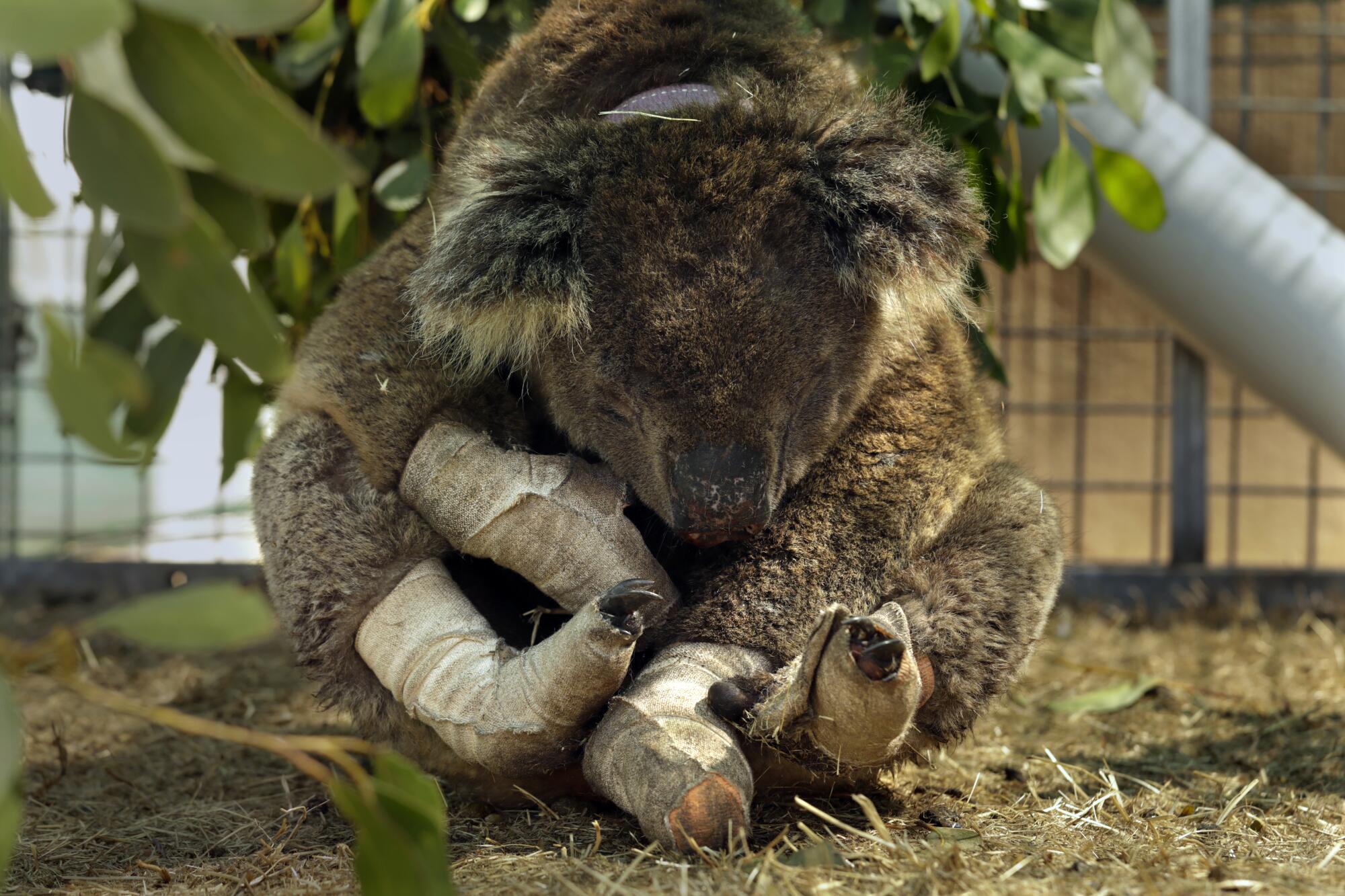
On Kangaroo Island, the Mitchells’ 50-acre property is surrounded by burn scars but was untouched by the blazes. The fires choked the skies for days with smoke but were clear on Monday for firefighters and their water-dropping aircraft. For weeks, the wildlife park has become a refuge for animals rescued by volunteers and passersby.
The carcasses of animals litter the shoulders of the roads that run across the island’s rugged landscape. Most are dead, and others are in such bad shape they uncharacteristically move toward humans, either unable to see or starved and disoriented.
“We just get out every morning and look,” said Shona Fisher, 59, who rescue workers say has brought in more than 70 koalas with her husband since the fires began. The pair have taken to visiting the island’s groves of commercially planted blue gum eucalyptus each morning to search for survivors.
At the park, there’s a pop-up tent where crews monitor medical equipment including IV drip bags, bandages, gauze and saucers filled with iodine. Nearby are laundry baskets where koalas are nestled, their burned paws bandaged.
Three weeks ago, the scene at the wildlife park was much different. The Mitchells’ low-slung ranch-style home had a small setup of cages and pens in the back for about 20 koalas and other animals, which was enough to treat an irregular stream of ailing wildlife while they continued to operate their park, cafe and other attractions for tourists.

But then the fires came. Two grew moderately out of lightning strikes on Dec. 20 and were on their way to being controlled when a third lightning strike on Dec. 30 created a monster blaze. Within five days, it consumed about a third of the island and, according to Mitchell, about 80% of the koalas’ island habitat.
For the world’s koala population, mounting losses on Kangaroo Island carry extra weight. The island’s animals are the only chlamydia-free koala population in Australia, making them a sort of insurance policy for the species as a whole.
But every loss, no matter the animal, hits home for the workers at the park.
“For a lot of us, we’re seeing a lot of death, and it’s not just at the park, unfortunately,” Haska said. “Wherever you drive on the island at the moment is a very grim picture.”
The fire has destroyed 65 homes here, some of them during a single night last week when winds carried embers over firefighters and overwhelmed their defenses.
A father and son trapped in their car were killed along a main highway and laid to rest this week. Firefighters on other fronts that night had to make difficult choices of which homes to save and which to abandon.
“It makes it hard, because you got locals there that want you to help them, but realistically, in the end, my crew’s lives are in danger, and I’ve got to protect them from something that we might not come out of,” said Gary Jenkins, a volunteer firefighter who battled the flames. “It was probably one of the worst things I have been through.”
Researchers backed by the San Diego Zoo are scrambling to save koalas threatened by the rampaging brush fires in Australia.
Local farmers also took a big hit, although the larger operations may be in a position to bounce back.
Nick Clark, who manages 10,500 fine-wool-producing Australian merino sheep on 3,000 acres of the island, falls into that category. When the fire made its run across the island last week, it consumed 85% of the pasture his animals fed on. It will take years for the land to recover, leading to increased labor and supply costs for the farmer, but he’s confident he can continue on.
On Kangaroo Island and elsewhere, he said, the farms are “getting bigger and the smaller guys getting squeezed out,” he said. “When the fire goes out, there’ll be a period of contemplation and reflection, and it’s easy to fall into a bit of despair.”
Some are calling the Australian fires an animal apocalypse — and a sign of what could happen in California as fires intensify and burn hotter, as they are expected to do under many climate change scenarios.
That prospect concerns many fire ecologists, who have long preached that fires are beneficial to native flora and fauna in California and other Western states, where ecosystems have adapted to regular blazes.
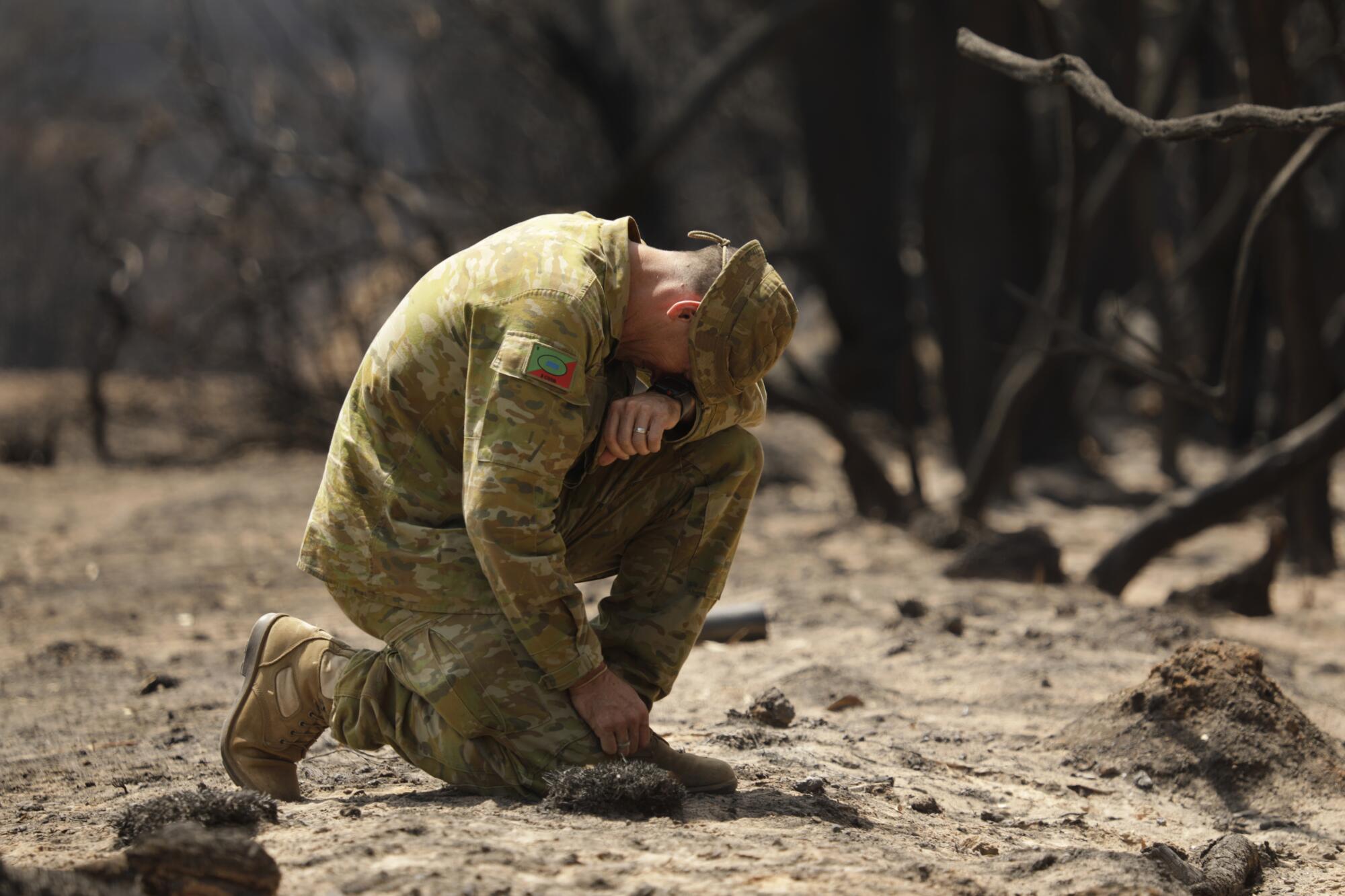
“We have a saying that pyro-diversity begets eco-diversity,” said Dominick DellaSala, chief scientist with the Ashland, Ore.-based Geos Institute, who has studied forest-fire ecology extensively in the western United States.
But the recent super-hot fires in California, and the widespread wildlife deaths in Australia, have some scientists questioning if these unnaturally intense blazes pose a threat to the conventional wisdom, at least in Australia.
Some scientists note there is a long history of wildlife perishing in big fires in California, but the impact has received little attention until now.
Robert Fisher, a California-based supervisory scientist for the U.S. Geological Survey, says wildlife often die in these blazes, but those losses are overshadowed, or not reported, because of the threat to the human population.
In the 2009 Station fire in Los Angeles, he said, “I saw thousands of dead animals ... deer, fish, turtles.”
Fisher said the lack of focus on animal carnage in U.S. fires might have something to do with the past loss of the continent’s iconic creatures, the equivalent of koalas, emus and kangaroos.
“We already wiped out the buffalo and grizzlies,” he said. “Can you imagine if thousands of grizzlies were burned? People would be going crazy.”
Across Australia, there is introspection on the topic of climate change — whether the country could have moved faster to acknowledge the causes of warming temperatures and better prepare for the effects. But at the Kangaroo Island Wildlife Park on Monday, the focus was on wildlife rescues.
“Everyone kept saying, ‘It’s going to happen, it’s going to happen, it’s going to happen.’ And it happened,” Mitchell said of the fires. “People want to blame someone, and my focus right now is on saving the animals. Maybe I’ll blame someone when I have time to think about it.”
Serna reported from Kangaroo Island, Australia. Rust reported from Menlo Park, Calif.
